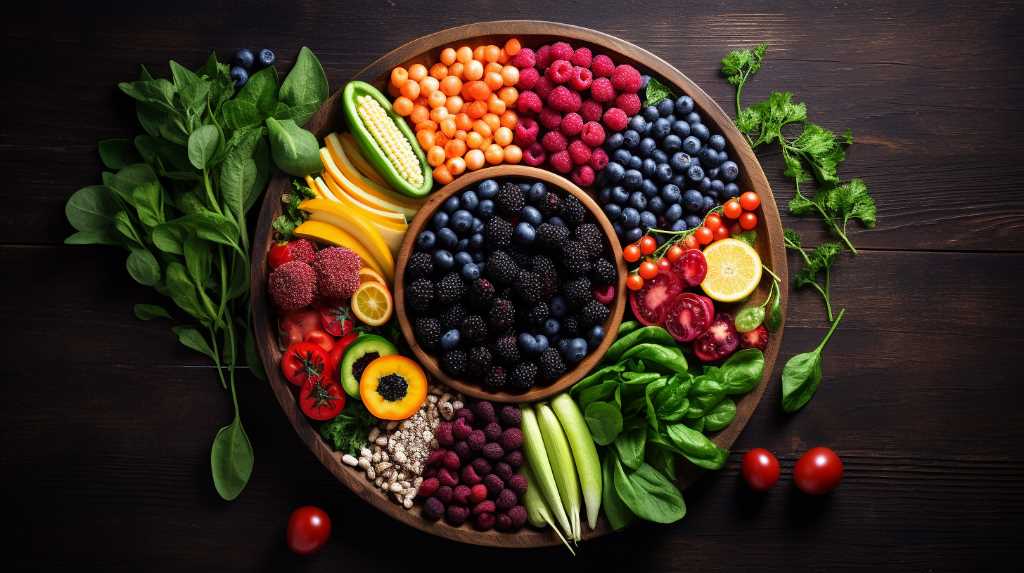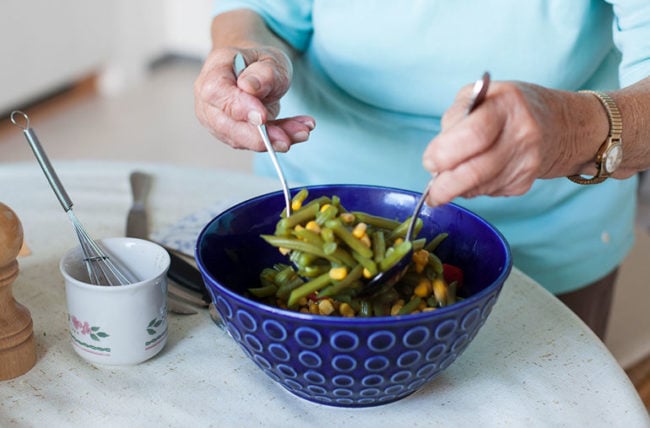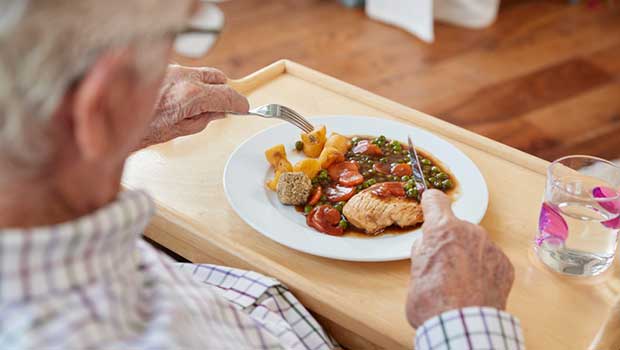
I've researched and compiled the top 10 healthy meal plans for the elderly, focusing on their specific nutritional needs. These meal plans include options like the Mediterranean Diet, DASH Diet, and vegetarian options, ensuring a well-rounded and fulfilling diet.
With considerations for low sodium, diabetes, gluten-free needs, weight management, and more, these meal plans aim to provide optimal nutrition for the golden years.
Stay healthy and enjoy your freedom with these delicious and nutritious options.
Mediterranean Diet Meal Plan
I've found that following a Mediterranean diet meal plan with its emphasis on fresh fruits and vegetables, whole grains, and lean proteins has helped me feel more energetic and maintain a healthy weight.
The benefits of the Mediterranean diet are well-documented. Numerous studies have shown that this eating pattern can reduce the risk of heart disease, lower blood pressure, and improve overall health. The Mediterranean diet is also rich in antioxidants, which can help protect against chronic diseases and slow down the aging process. Additionally, the diet includes plenty of omega-3 fatty acids, which are known for their anti-inflammatory properties.
To get started with the Mediterranean diet, there are plenty of delicious recipes available that incorporate the key ingredients. From Greek salad to roasted vegetables with olive oil, there are endless possibilities to enjoy a healthy and flavorful Mediterranean meal.

DASH Diet Meal Plan
The DASH diet, which stands for Dietary Approaches to Stop Hypertension, has been shown to have numerous benefits for cardiovascular health. It emphasizes consuming foods that are low in saturated fat, cholesterol, and sodium, while also promoting the intake of nutrients like potassium, calcium, and magnesium.
The DASH diet meal plan includes incorporating more fruits and vegetables into my meals, as well as reducing sodium intake to improve my overall health. By following the DASH diet, individuals can lower their blood pressure and reduce their risk of developing heart disease, stroke, and other chronic conditions.

To implement this meal plan, one can try delicious DASH diet recipes that include colorful salads, lean proteins, whole grains, and plenty of fruits and vegetables. By making these dietary changes, one can improve their overall health and well-being.
Vegetarian Meal Plan
I have discovered that incorporating a variety of plant-based proteins into my meals is a key element of a nutritious vegetarian meal plan. As a vegetarian, finding alternative protein sources is essential for meeting my daily nutritional needs.
Fortunately, there are plenty of vegetarian protein sources available that can be easily incorporated into my meals. Legumes such as lentils, chickpeas, and black beans are excellent sources of protein, as well as tofu, tempeh, and edamame. Nuts and seeds, such as almonds, chia seeds, and hemp seeds, are also great options.
Incorporating these protein-rich foods into my meals ensures that I'm getting the necessary amino acids and nutrients for optimal health. In terms of meal prep, I find it helpful to batch cook protein-rich foods, such as lentil soups or tofu stir-fries, and store them in the fridge or freezer for quick and easy meals throughout the week.
Additionally, planning meals in advance and including a variety of protein sources ensures that I'm getting a well-rounded and nutritious vegetarian diet.

Low Sodium Meal Plan
A low sodium meal plan is a great way to improve heart health and manage blood pressure. By reducing sodium intake, individuals can lower their risk of developing conditions such as hypertension and cardiovascular disease.
In this discussion, we'll explore the benefits of a low sodium meal plan, as well as share some delicious low sodium recipes that are both nutritious and flavorful.
Benefits of Low Sodium
My doctor recommended incorporating a low sodium meal plan into my daily routine to reap the benefits of reduced sodium intake. It's important to limit sodium in our diets because excessive sodium consumption can lead to high blood pressure and increase the risk of heart disease. By following a low sodium meal plan, I can help lower my blood pressure and improve my overall cardiovascular health.
However, it's not just about reducing sodium; it's also about increasing potassium intake. Potassium plays a crucial role in maintaining healthy blood pressure levels. It helps counteract the effects of sodium by relaxing blood vessel walls and promoting proper fluid balance. Incorporating foods rich in potassium, such as bananas, avocados, and spinach, alongside a low sodium meal plan can have significant health benefits, supporting heart health and reducing the risk of chronic diseases.
Delicious Low Sodium Recipes
There are plenty of delicious low sodium recipes available online, so it's easy to find flavorful meals that are also good for my health. Cooking with less sodium has become a priority for me, as excessive sodium intake has been linked to high blood pressure and other health issues.
Here are some tips for reducing sodium intake and some low sodium snack ideas:
Read labels: Pay attention to the sodium content of packaged foods and opt for low sodium or sodium-free options. Use herbs and spices: Enhance the flavor of your dishes with herbs and spices instead of relying on salt. Experiment with different ingredients: Try using lemon juice, vinegar, or citrus zest to add a tangy flavor to your meals.Diabetic-Friendly Meal Plan
Following a diabetic-friendly meal plan has helped me manage my blood sugar levels effectively. It's essential to choose snacks and desserts that are suitable for individuals with diabetes.

When it comes to diabetic-friendly snacks, it's important to opt for options that are low in sugar and carbohydrates. Some great snack ideas include nuts, seeds, Greek yogurt, and fresh fruits. These choices provide essential nutrients without causing a spike in blood sugar levels.
As for desserts, there are plenty of diabetic-friendly options available. Sugar-free or low-sugar desserts made with artificial sweeteners can be a good choice. Additionally, desserts using alternative sweeteners like stevia or monk fruit extract can also be enjoyed.
It's important to remember that portion control click here is key when indulging in desserts, even if they're diabetic-friendly.
Heart-Healthy Meal Plan
I've found that a heart-healthy meal plan is essential for maintaining cardiovascular health.
To achieve this, I focus on including low-sodium options to reduce blood pressure, incorporating omega-3 fatty acids for their anti-inflammatory properties, and choosing high-fiber alternatives to support healthy cholesterol levels.
Low-Sodium Options
I'm currently researching low-sodium options to include in my heart-healthy meal plan for the elderly. Sodium intake recommendations for adults is around 2,300 milligrams per day, but for those with heart conditions or high blood pressure, it's advised to limit sodium intake to 1,500 milligrams or less.
Here are three low-sodium substitutes that can help reduce sodium content while still adding flavor to meals:

Herbs and Spices: Instead of relying on salt for flavor, experiment with herbs and spices like basil, rosemary, or turmeric. They can enhance the taste of dishes without the added sodium.
Citrus Fruits: Squeeze fresh lemon or lime juice onto dishes to add a tangy flavor. Citrus fruits are a great way to enhance taste without increasing sodium content.
Homemade Stocks: Opt for homemade stocks or broths instead of store-bought versions, as they tend to have high sodium levels. By making your own, you can control the amount of salt added.
Omega-3 Fatty Acids
Including omega-3 fatty acids in a heart-healthy meal plan can provide numerous benefits for the elderly. Omega-3s are essential nutrients that play a crucial role in maintaining heart health and reducing inflammation. Research suggests that omega-3 supplements can help lower the risk of heart disease, stroke, and high blood pressure in older adults.
Additionally, omega-3s have been found to improve cognitive function and reduce the risk of developing Alzheimer's disease and dementia. There are various sources of omega-3s, including fatty fish like salmon and sardines, as well as plant-based options like flaxseeds and chia seeds. Incorporating these foods into daily meals can ensure an adequate intake of omega-3 fatty acids.
Furthermore, for those who've difficulty obtaining enough omega-3s from diet alone, omega-3 supplements can be a convenient and effective option.
High-Fiber Alternatives
What are some high-fiber alternatives that can be included in a heart-healthy meal plan for the elderly?

Including fiber-rich foods in a heart-healthy meal plan for the elderly can provide numerous benefits. Here are some high-fiber alternatives to consider:
Whole grains: Incorporating whole grains like brown rice, quinoa, and whole wheat bread can boost fiber intake and promote heart health.
Fruits and vegetables: Opt for fiber-rich fruits like berries, apples, and pears, as well as vegetables such as broccoli, carrots, and Brussels sprouts.
Legumes: Adding beans, lentils, and chickpeas to meals can significantly increase fiber content and provide essential nutrients.
These high-fiber alternatives not only promote digestive health but also help to lower cholesterol levels, control blood sugar, and maintain a healthy weight. Including a variety of these fiber-rich foods can contribute to a well-rounded and heart-healthy meal plan for the elderly.
Gluten-Free Meal Plan
I have found a great gluten-free meal plan that includes a variety of delicious and nutritious options for seniors. As we age, it becomes increasingly important to prioritize our health and well-being. Following a gluten-free diet can be beneficial for seniors with gluten sensitivities or celiac disease. The good news is that there are plenty of gluten-free recipes and substitutes available that can help seniors maintain a healthy and balanced diet.
When planning a gluten-free meal plan for seniors, it's important to focus on whole, unprocessed foods. Incorporating a variety of fruits, vegetables, lean proteins, and gluten-free grains such as quinoa or brown rice can provide the necessary nutrients. For those who enjoy baking, using gluten-free substitutes like almond flour or coconut flour can help recreate favorite recipes without compromising taste or nutritional value.

Weight Management Meal Plan
Maintaining a healthy weight is crucial, so I'll focus on creating a balanced weight management meal plan that includes lean proteins and plenty of fiber-rich foods. When it comes to weight management, meal prep and portion control are key.
Here are three important tips to keep in mind:
Plan your meals in advance: Meal prepping allows you to have healthy options readily available, making it easier to stick to your weight management goals. Take some time each week to plan your meals and ensure they're well-balanced and nutritious.
Practice portion control: Pay attention to your portion sizes to avoid overeating. Use smaller plates and bowls, and listen to your body's hunger and fullness cues. Remember, it's not just what you eat, but how much you eat that matters.
Incorporate a variety of foods: Aim to include different food groups in your meals to ensure you're getting a wide range of nutrients. Include lean proteins like chicken, fish, and tofu, along with plenty of fruits, vegetables, whole grains, and healthy fats.
Nutrient-Rich Meal Plan
To ensure optimal health, I'll create a nutrient-rich meal plan that includes a variety of fruits, vegetables, lean proteins, and whole grains.
As we age, it becomes even more crucial to prioritize our nutrition and make conscious choices about what we eat. Including high protein options in our meals is important for maintaining muscle mass and supporting overall health.

Lean proteins, such as chicken, fish, tofu, and beans, can provide the necessary amino acids our bodies need.
Additionally, incorporating nutrient-dense snacks throughout the day can help us meet our nutritional needs. Snacks like Greek yogurt, nuts, seeds, and fresh fruits are excellent choices.
Anti-Inflammatory Meal Plan
Including foods rich in omega-3 fatty acids and antioxidants, such as salmon and blueberries, can help reduce inflammation in my body and improve my overall health. Inflammation is a natural response by the body to injury or infection, but chronic inflammation can lead to various health issues, including heart disease, diabetes, and arthritis.
An anti-inflammatory meal plan can help combat this chronic inflammation and promote better health. Here are three key ingredients that provide anti-inflammatory benefits:
Turmeric: This spice contains curcumin, which has been shown to have powerful anti-inflammatory effects.
Leafy greens: Vegetables like kale and spinach are packed with vitamins, minerals, and antioxidants that can help reduce inflammation.
Olive oil: This healthy fat contains oleocanthal, which has been found to have similar anti-inflammatory effects as ibuprofen.

Frequently Asked Questions
What Are Some Common Nutrient Deficiencies in the Elderly and How Can They Be Addressed Through Meal Plans?
Some common nutrient deficiencies in the elderly include vitamin D, calcium, and vitamin B12. These can be addressed through meal plans that incorporate foods rich in these nutrients, such as dairy products, fish, and fortified cereals.
Are There Any Specific Meal Plans Recommended for Seniors With Specific Health Conditions, Such as Osteoporosis or Arthritis?
For seniors with specific health conditions like osteoporosis or arthritis, there are meal plans tailored to their needs. These plans may include specific dietary recommendations and modifications for seniors with difficulty chewing or swallowing.
How Can Portion Sizes Be Adjusted in These Meal Plans to Accommodate the Lower Calorie Needs of Older Adults?
To adjust portion sizes for older adults and accommodate their lower calorie needs, it's important to consider their individual requirements. Consulting with a healthcare professional or registered dietitian can provide personalized guidance and ensure optimal nutrition.
Are There Any Meal Plans Specifically Designed for Seniors With Difficulty Chewing or Swallowing?
Yes, there are meal options available for seniors with difficulty swallowing. These meal plans are specifically designed to be easy to chew and swallow, providing the necessary nutrition while addressing swallowing difficulties.
Can These Meal Plans Be Customized to Cater to Individual Preferences and Dietary Restrictions, Such as Allergies or Intolerances?
Yes, these meal plans can be customized to cater to individual preferences and dietary restrictions. However, there may be challenges in achieving complete customization. The benefits of personalized nutrition include improved health outcomes and satisfaction with meals.
Conclusion
In conclusion, providing the elderly with proper nutrition is essential for maintaining their health and well-being.
The top 10 healthy meal plans mentioned in this article, such as the Mediterranean Diet, DASH Diet, and Diabetic-Friendly Meal Plan, offer a variety of options to meet the nutritional needs of older adults.

By following these meal plans, seniors can ensure they receive the necessary nutrients and reduce the risk of various health conditions.
It's important to consult with a healthcare professional or registered dietitian to tailor the meal plan to individual needs.